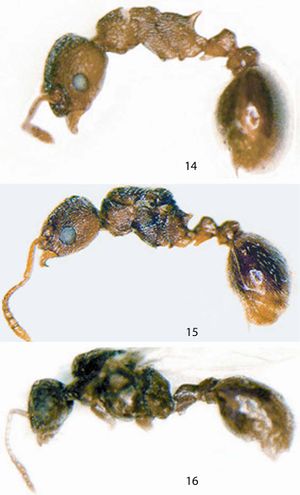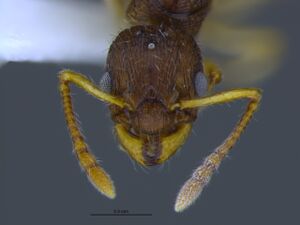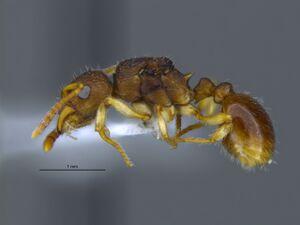Myrmica semiparasitica
| Myrmica semiparasitica | |
|---|---|

| |
| Scientific classification | |
| Kingdom: | Animalia |
| Phylum: | Arthropoda |
| Class: | Insecta |
| Order: | Hymenoptera |
| Family: | Formicidae |
| Subfamily: | Myrmicinae |
| Tribe: | Myrmicini |
| Genus: | Myrmica |
| Species: | M. semiparasitica |
| Binomial name | |
| Myrmica semiparasitica Francoeur, 2007 | |
The fact that the species was found in a colony of Myrmica punctiventris with the two female forms and males, and that it performed nuptial flights support the probability of a temporary parasitic ant in nature. S. Cover collected his specimens from a hickory nut in a rich oak woods of the East Farm Preserve. The host species, as well as Myrmica pinetorum, are found in red oak stands on and around Mont Rigaud, Québec. (Francoeur, 2007)
| At a Glance | • Temporary parasite |
Identification
A member of the punctiventris group. This is the smallest species of the group. The reduced size is more obvious in the queens and males. The sternal process of the petiole comports with the parasitic syndrome of Wilson (1971). The frontal lobes are similar to the ones of Myrmica punctiventris while the general size of worker, shorter scapes and spines, the relative proportions of the waist, the delicate rugulate sculpture are closer to Myrmica pinetorum. (Francoeur, 2007)
Keys including this Species
Distribution
Southern Québec to New England.
Latitudinal Distribution Pattern
Latitudinal Range: 45.466667° to 40.903432°.
| North Temperate |
North Subtropical |
Tropical | South Subtropical |
South Temperate |
- Source: AntMaps
Distribution based on Regional Taxon Lists
Nearctic Region: United States (type locality).
Distribution based on AntMaps
Distribution based on AntWeb specimens
Check data from AntWeb
Countries Occupied
| Number of countries occupied by this species based on AntWiki Regional Taxon Lists. In general, fewer countries occupied indicates a narrower range, while more countries indicates a more widespread species. |

|
Estimated Abundance
| Relative abundance based on number of AntMaps records per species (this species within the purple bar). Fewer records (to the left) indicates a less abundant/encountered species while more records (to the right) indicates more abundant/encountered species. |

|
Biology
Castes
 
| |
| . | |
Queen
   
| |
| . | |
Male
   
| |
| . | |
Nomenclature
The following information is derived from Barry Bolton's Online Catalogue of the Ants of the World.
- semiparasitica. Myrmica semiparasitica Francoeur, 2007: 161, figs. 14-19 (w.q.m.) U.S.A.
Unless otherwise noted the text for the remainder of this section is reported from the publication that includes the original description.
Description
Worker
Head in full face view subquadrate with almost straight sides; preoccipital margin straight and corners rounded. Eyes rather large, convex and suboval, located on the mid point of the head sides. Anterior margin of clypeus angulo-convex; lateral wings thin and flat, apex crossed by genal carinae. In dorsal view frontal lamellae small. Extending partly over the antennal articulation, loosely triangular or angulo-convex in shape; posterior margin feebly narrower and ending as a carinae merging into the head dorsum. Antennae: fossae rather shallow; scapes shorter than head length and width; in profile base evently bent, dorso-ventrally flattened with a feeble dorsal concavity; in dorsal view shaft width regular along its axis. Funiculus segments 3-5 as large as long, others longer than broad; apical club of 4 segments.
Mesosoma in profile, mesometasternum external margin horizontally aligned, promesonotum flattened, distinctly higher than propodeum, both joining through an angle at the mesopropodeal furrow which remains shallow. In dorsal view promesonotum typically pear-like, posterior end of mesonotum narrower and angulo-convex. Strigil of protibia with basal tooth; meso and metatibiae with minute to vestigial spurs, very finely and shortly pectinated on the distal third or only barbulate at apex. Propodeal lobes small, with a posterodorsal angle. Propodeal spines dentiform and feebly pointed, subparallel, shorter than the distance separating their tips, projecting backwards and upwards at 45°. Petiole short, higher than wide; peduncle hidden by propodeal lobes; node seen in profile anterior face slightly concave, forming a right angle with the dorsal surface which is rather flattened, meeting the posterior face through a rounded angle; sternum with a lamellar process varying in size. Postpetiole shorter than high and wide, the latters about equal; node profile typically with very short anterior and posterior vertical surfaces, united by a large convex one; sternal process strongly convex or subglobular, making 1/3 of the postpetiole height.
Mandibles faintly striated with ciliated punctures. Frons and clypeus with parallel, acute and thin carinae, spreading fan-wise towards the occiput, separated by faintly microsculptured surface; reticulations on temples and the preoccipital margin. Antennal fossae with parallel and convex carinae. Mesosoma generally striato-rugulose; rugulae acute and largely reticulated on on promesonotum, more rounded and parallel on mesopleurae and dorsum of propodeum. Space between spines with transverse and faint lines, remaining ventral area smooth. Petiole and postpetiole rugose. Gaster smooth and shining; first segment with large rounded punctures. Long and erect hairs moderately abundant on body; suberect on scapes. Gastric dorsum without distinct pubescence. General body color light to dark reddish brown; appendages lighter or more yellowish.
Queen
Basically similar to workers in shape of head, characters of sculpture, color and pilosity of body except the following. Head with 3 proportionatly large ocelli. Usual distinct mesosoma development of a queen and body size larger. Mesosoma rugulose; reticulations on lateral areas of promesonotum; central part of mesonotum with diverging rugulae. Ventral lamella of petiole digitiform or angulate, varying in size. Sculpture coarser on posterior half dorsum of head, on petiole and postpetiole, reduced on anteromedian third of pronotum, behind the collar. Transverse groove of mesopleurae narrow and impressed; katepisternum with thinner rugulae, separated, obliquely parallel. Wings translucid. Submarginal cell of anterior wing not always partly subdivided.
Male
Smaller than queen. In full face view head slightly longer than broad, narrower before eyes, with shallow elongated antennal fossae, posterior half evenly convex. Mandibles elongated, blade subtriangular; masticatory margin quite varying, with 1-4 apical teeth followed by 1-2 denticles. Clypeus convex, anterior margin angulo-convex. Malar space short. Frontal triangle wide and shallow and more or less delimited. Frontal lobes reduced to minute but distinct carinae, diverging posteriorly. Antennae with 13 segments; scapes short, equal to less than the first 3 funiculus segments; in profile scape base with a faint dorsal flattening; length of second funicular segment equal to next two; funicular club of 5 segments. Eyes large and globular. Ocelli proportionately large, 0.07-0.08 mm in diameter; distance between the posterior two equal to diameter of 3 anterior ocelli.
In lateral view, mesosoma rather long; mesonotum high. Mayrian furrows not or feebly impressed. Spurs of meso- and metalegs varying in size and development from minutely pectinated to normal. Metapleural lamellae small and largely convex. Wings as in queen. Propodeum with two more or less developed protuberences marked by carinae, surface beteen them smooth and shining; spiracles rounded and well marked. In profile petiole short, with an anterior peduncle hidden by propodeal lobes; ventral margin with a lamellar process rectangular in shape, sometimes angulate anteriorly; summit of node convex with few longitudinal rugulae. Postpetiole shorter than high and wide; about as large high; in profile anterior and dorsal surfaces of dorsum forming a convex slope with summit anding posteriorly by a very short declivity; sternum longer than high, ventral margin more or less convex.
Head sculpture generaly fine; rugulae present or not on frons, shorter and malar spaces, reticulated on temples. Mandibles very faintly sculptured. Clypeus very faintly microsculptured, with a short median carina originating from the median angle of anterior margin. Frontal triangle partly punctulate and smooth. Antennae with suberect fine hairs longer than the width of segments, but shorter on funiculus club. Pronotum densely shagreened; mesoscutum mostly smooth and shining. Mayrian furrow of mesonotum as a thin line from which originate short rugulae. Mesometapleurae with parallel rugulae obliquly oriented, transverse grooves feebly impressed. Propodeal protuberences with a row of fine erect hairs. Lateral sides of petiole faintly shagreened with some rugulae; median area of dorsum smooth and shining. Sides of postpetiole shagreened, smooth elsewhere Body pilosity moderately abundant, fine, erect to decumbent; denser and longer on head and legs. Gaster smooth and shining; first segment without large punctures. Body color black to blackish brown; appendages lighter.
Type Material
Holotype worker and 14 paratypes: USA, Long Island, Suffolk County, New York, U.S.A., 2.v.1982 (S. P. Cover), a nest series collected including 9 workers, 1 ergatogyne, 2 queens and 3 males. Additional paratypes: 11 alate queens, 23 males, CANADA, Mont Rigaud, Rigaud, Québec, (2 series: 14.viii.1981, 30.vii & 16.viii.1982, captured among swarmings of Myrmica on the mountain top (Leprince and Francoeur 1986). Holotype worker and most paratypes in Museum of Comparative Zoology; paratype workers, queens, and males also in Los Angeles County Museum of Natural History, National Museum of Natural History, and CAFR; paratype ergatogyne in Museum of Comparative Zoology.
Etymology
Meaning partly parasitic, since this species is probably a temporary social parasite.
References
- Francoeur, A. 2007. The Myrmica punctiventris and M. crassirugis species groups in the Nearctic region. Pages 153-186 in R. R. Snelling, B. L. Fisher, and P. S. Ward, editors. Advances in ant systematics (Hymenoptera: Formicidae): homage to E. O. Wilson - 50 years of contributions. Memoirs of the American Entomological Institute, vol. 80, Gainesville, FL, 690 p.
- Ivanov, K. 2019. The ants of Ohio (Hymenoptera, Formicidae): an updated checklist. Journal of Hymenoptera Research 70: 65–87 (doi:10.3897@jhr.70.35207).
- Jansen, G., Savolainen, R., Vepsäläinen, K. 2010. Phylogeny, divergence-time estimation, biogeography and social parasite–host relationships of the Holarctic ant genus Myrmica (Hymenoptera: Formicidae). Molecular Phylogenetics and Evolution 561, 294–304 (doi:10.1016/j.ympev.2010.01.029).
References based on Global Ant Biodiversity Informatics
- Del Toro, I. 2010. PERSONAL COMMUNICATION. MUSEUM RECORDS COLLATED BY ISRAEL DEL TORO
- Ellison A. M. 2012. The Ants of Nantucket: Unexpectedly High Biodiversity in an Anthropogenic Landscape. Northeastern Naturalist 19(1): 43-66.
- Francoeur A. 2007. The Myrmica punctiventris and M. crassirugis species groups in the Nearctic region. Memoirs of the American Entomological Institute 80: 153-185.
- Francoeur A., and K. Ivanov. 2008. The known range of Myrmica semiparasitica (Formicidae: Hymenoptera). Notes from Underground 13(1): 3 pages.
- Ivanov K. 2015. Checklist of the ants (Hymenoptera: Formicidae) of Ohio. Conference: Ohio Natural History Conference, At Columbus OH
- Ivanov, K. 2019. The ants of Ohio (Hymenoptera, Formicidae): an updated checklist. Journal of Hymenoptera Research 70: 65–87.

